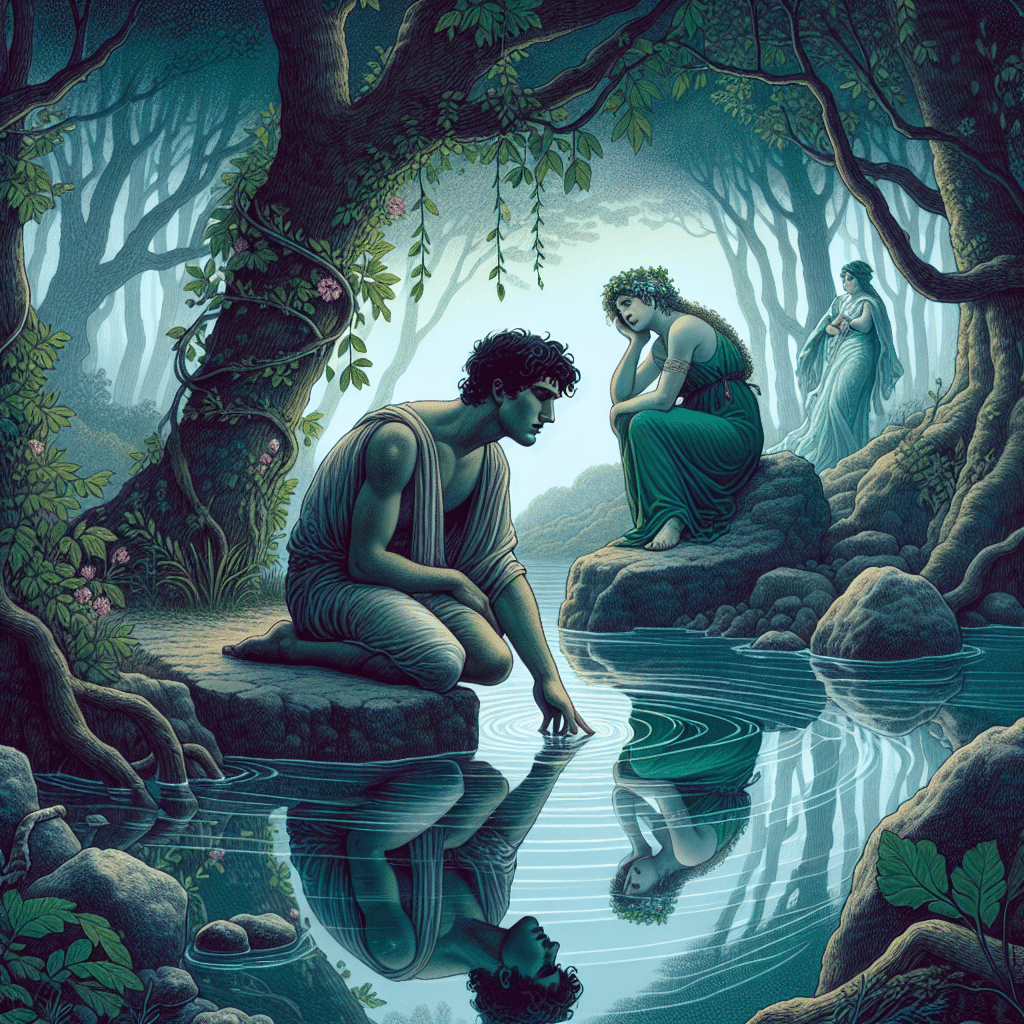Introduction
The painting “Narcissus” is a poignant exploration of self-obsession and the interplay between beauty and tragedy. Created by the renowned artist Caravaggio around 1599, this stunning piece depicts the moment from Ovid’s “Metamorphoses” where Narcissus, entranced by his own reflection in a pool, becomes the embodiment of vanity. The use of chiaroscuro highlights the tension between light and shadow, drawing the viewer into Narcissus’s mesmerizing visage. This painting not only serves as an artistic narration of mythological themes but also raises poignant questions about identity, perception, and the consequences of self-love. Caravaggio’s mastery in portraying intense realism and emotional depth allows for a profound engagement with the subject matter, inviting reflection on the darker sides of human nature.
Understanding the Myth of Narcissus
The story of Narcissus originates from Greek mythology, where he is infamous for his beauty and tragic fate. According to Ovid, Narcissus was a strikingly handsome young man who captivated all who beheld him. However, he met his demise when he fell in love with his own reflection in a pool of water, becoming entranced to the point of neglecting his surroundings and ultimately succumbing to despair. The myth serves as a cautionary tale about the perils of vanity and excessive self-love, making it a rich subject for artistic interpretation.
Caravaggio’s Artistic Techniques
Caravaggio is celebrated for his revolutionary use of chiaroscuro—a technique that employs strong contrasts between light and dark to create a sense of volume and drama. In “Narcissus,” the lighting focuses on the figure, emphasizing the smooth contours of his face and the shimmering water’s surface, while the dark background enhances the feeling of isolation. This technique not only elevates Narcissus’s physical beauty but also symbolizes the emotional depth of his tragic fate, compelling viewers to confront the implications of his narcissistic behavior.
Composition and Symbolism in the Painting
The composition of “Narcissus” is thoughtfully arranged, directing the viewer’s gaze straight to the figure’s reflection. The stillness of the water mirrors Narcissus’s image, representing how he is frozen in time—both literally and metaphorically. The very act of gazing at oneself becomes a motif of obsession, as Narcissus is more engrossed in his image than in the world around him. The painting also delves into themes of self-destruction; as Narcissus inches closer to the water, he becomes increasingly detached from reality, encapsulating the idea that self-obsession can lead to one’s downfall.
Comparative Analysis with Other Depictions
While Caravaggio’s interpretation of Narcissus is grounded in realism, other artists have approached the myth with varied stylistic choices. For instance, the 19th-century artist John William Waterhouse depicted Narcissus in a more ethereal and romanticized manner, emphasizing the beauty of youth and nature. This divergence in artistic perspectives reflects broader cultural shifts in how man’s relationship with self-identity and nature is viewed across eras. Caravaggio’s version, with its raw emotion and stark realism, reinforces the tragic consequences of excessive vanity, positioning the viewer to interact critically with the subject matter.
The Psychological Implications
Narcissus’s story holds significant implications in contemporary discussions about identity and self-obsession, particularly in the context of social media’s role in our lives. Today, the ‘Narcissus effect’ has been coined to describe those who become overly preoccupied with their digital representations, echoing the mythological themes of longing and loss. This modern interpretation invites reflection on society’s values surrounding beauty and self-perception, encouraging viewers to consider the balance between self-love and self-destruction.
Impact on Art and Culture
Caravaggio’s portrayal of Narcissus has resonated widely throughout art history and popular culture. It has inspired countless adaptations and interpretations across different media, solidifying its place in the collective consciousness. Artists, writers, and filmmakers frequently reference the myth of Narcissus to address themes of identity, egotism, and the consequences of self-absorption, affirming its enduring relevance.
Conclusion
“Narcissus” by Caravaggio represents more than just a visual exploration of a myth; it opens a dialogue about the themes of self-obsession, identity, and the impact of beauty. Through his masterful techniques and emotional depth, Caravaggio’s painting invites the viewer to reflect on their own relationship with self-image and the world. As we continue to grapple with the implications of narcissism in contemporary society, the story of Narcissus remains a timeless reminder of the delicate balance between self-love and self-destruction.
FAQs about the Painting Narcissus
What does the painting Narcissus symbolize?
The painting symbolizes the dangers of vanity and self-obsession while exploring themes of identity and emotional isolation.
Who painted Narcissus and when?
Narcissus was painted by Caravaggio around the year 1599.
What technique did Caravaggio use in the painting?
Caravaggio employed chiaroscuro, creating dramatic contrasts between light and shadow to enhance the emotional impact of the scene.
How does Narcissus relate to modern culture?
The myth of Narcissus has contemporary relevance, particularly in relation to discussions about self-perception and the effects of social media on identity.
Are there other famous artworks about Narcissus?
Yes, numerous artists have portrayed Narcissus, including John William Waterhouse, whose works often have a more romanticized interpretation of the myth.



